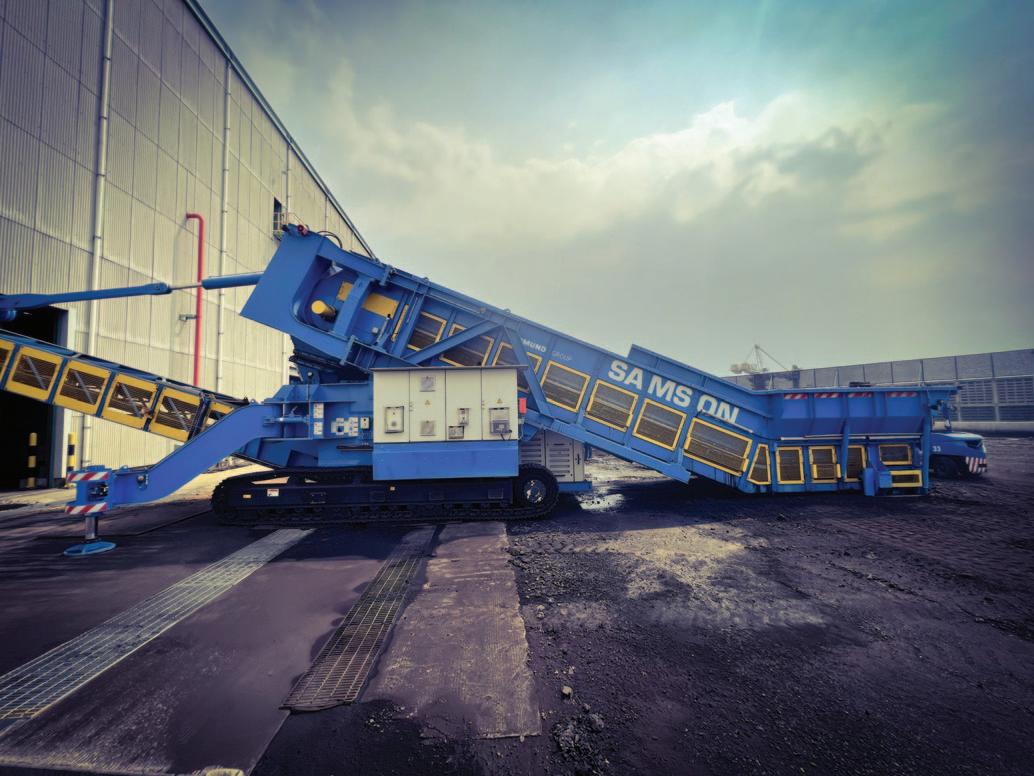
3 minute read
A question of coal
And How To Handle It
Louise Dodds-Ely
Equipment and applications used in the handling of coal
A Unique Operational Challenge
With eight billion tonnes used in 2022, coal is the world’s greatest source of energy for generating electricity and one of the most abundant fossil fuels, according to the International Energy Agency, writes Petar Karaivanov, Marketing & Communications Manager, SAMSON Materials Handling
Because of their considerable environmental effect, such materials are strictly regulated by municipal governments, posing a unique handling difficulty. However, because coal handling equipment and applications are in such high demand across a wide range of sectors and businesses, the equipment and applications used in coal handling are always developing to keep up with the ever-changing regulatory landscape.
SHIP TO SHORE AND VICE-VERSA
The following main components comprise a typical coal handling operation: delivery, unloading, preparation, transfer, outdoor/ covered storage, weighing and measuring, and furnace fire. Coal is typically transported and handled by ships (for import/export) and stored in power plants in tips, bunkers, or large-capacity silos. AUMUND has a wide range of equipment specialized to stockpiling and transport inside the yard. The variety of different handling methods, as well as the location and size of the handling yard, must be considered while selecting handling equipment. The SAMSON Eco Hopper is the prime selection for ship-unloading. It is an environmentally friendly solution that meets all requirements for the effective import of dry bulk goods. The hoppers are built to accommodate the characteristics and flow qualities of almost any bulk material. The hoppers are equipped with extensive dust control features, multiple discharge options: to conveyor, to truck, via telescopic chute, through ancillary material feeder, and multiple travel options: rail, static or pneumatic tyre mounted, or powered and towable travel, which is important to note when handling coal. Because the procedure is normally carried out with shiploader equipment, multiple designs are necessary to accommodate every type of vessel, from barges to post-Panamax size, as well as the size of the quay. The SAMSON Mobile Shiploaders are a low-cost, quickturnaround solution with total flexibility. Because of the varying needs at different ports, this equipment may be utilized alone or in conjunction with a single or double Samson advantages include dust-free loading into the vessel hold and quick trimming of the entire vessel.
Around The Yard
As coal reaches the handling yards around bulk port terminals, it is then distributed via multiple discharge options: to conveyor, to truck, with telescopic chute and more. Depending on the capabilities of the yard, the material is stored, various types of equipment may be used.
Truck unloading: the Material Feeder v is a very good option for handling coal around the yard when it comes to redistribution. It is a high-performance truck unloader with proven reliability for continuous process industries. It receives bulk materials directly from tipping trucks and loading shovels, a controlled discharge rate. Installed above ground, with no need for deep pits and expensive civil engineering works, it is a flexible alternative to traditional underground hoppers. The wide belt design principle used allows any material to be reliably conveyed without the risk of bridging or blockage. Tracked or wheeled versions are available.

Stockpiling (outdoor and indoor): v stockpiling is an efficient, cost-effective storage solution. There are several possibilities for terminal operators depending on the size of the yard and the height of the piles — conveyors, stackers, double or single handling equipment. The SAMSON mobile STORMAJOR® for example expands stockpiling, barge loading, and railcarloading capabilities. It offers the unique feature of complete mobility, allowing universal applications, as well as a radial outloading boom on a single chassis. It can accept a wide range of materials straight from tipping trucks, shovels, or articulated dump trucks, thus providing the performance of a fixed installation while requiring no permanent infrastructure.
Conclusion
Coal handling as well as other various types of materials located on a bulk terminal depends on several factors: financial investment costs; size of yard; current or future equipment investments or upgrades; and location of the terminal, especially if situated next to a living surrounding where environmental applications must be considered even further. Due to these criteria, and the ongoing high demand for coal while the world makes a transition to electrical power, AUMUND will continue to observe new and improved ways of handling this material.
The above-mentioned examples, not limited to, are some of the market’s leading equipment handling options. Various upgrades, sizes and handling rates are subject to the above-mentioned criteria, resulting in disruptive new equipment challenging engineers around the world. Future bulk cargo stockyards must offer flexible and environmentally friendly import and export solutions coal if they seek to increase the maximum potential returns of investments and increase the lifespan of equipment.
Ports handling dry bulk need to consider the vast differences between handling containers and the issues faced with bulk goods.
About The Aumund Group
The AUMUND Group is active worldwide. The conveying and storage specialist has special expertise at its disposal when dealing with bulk materials. With their high degree of individuality, both its technically sophisticated as well as innovative products have contributed to the AUMUND Group today being a market leader in many areas of conveying and storage technology. The manufacturing companies AUMUND Fördertechnik GmbH (Rheinberg, Germany), SCHADE Lagertechnik GmbH (Gelsenkirchen, Germany), SAMSON Materials Handling Ltd (Ely, England), TILEMANN GmbH Chains & Components (Essen, Germany) as well as AUMUND Group Field Service GmbH and AUMUND Logistic GmbH (Rheinberg, Germany) are consolidated under the umbrella of the AUMUND Group.
The global conveying and storage technology business is spearheaded through a total of 19 locations in Asia, Europe, North and South America and a total of five warehouses in Germany, USA, Brazil, Hong Kong and Saudi Arabia.










